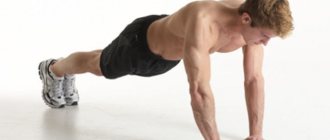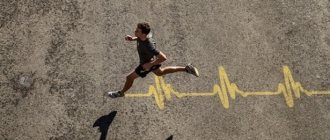When engaging in any type of physical activity, you need to be able to observe and track your breathing. It largely determines how quickly you get tired, whether you can develop the necessary training rhythm and increase your body’s endurance. In this material you will find valuable information on how to breathe correctly when running.
Why is it important
During sports exercises, the respiratory system performs the following functions:
- Saturates with oxygen. If its quantity is insufficient, the effectiveness of training is significantly reduced.
- Helps increase the duration of your run and get rid of excess glycogen.
- Reduces the stress factor when exerting stress on the body.
- Normalizes brain function, stimulates its activity, which has a positive effect on coordination.
- Allows you to regulate your heart rate. Using different techniques, you can calm or speed up your heartbeat.
- Promotes more fruitful fat burning: completed fats are burned only under conditions of a large volume of oxygen.
What types of endurance are there?
There are several types of endurance:
- aerobic;
- anaerobic;
- general.
The definition of general endurance implies the body's ability to perform non-specific activities that do not require large energy expenditures from the body.
Anaerobic means the body works when there is a lack of oxygen. The body is forced to spend a large amount of internal resources to perform the exercise. Aerobic endurance involves working through oxygen nutrition.
Anaerobic endurance is further divided into several types:
- express;
- speed-strength;
- coordination;
- power
How we breathe
The human respiratory system is directly connected to the circulatory system. Thanks to this connection, oxygen is extracted from the inhaled air mass, enters hemoglobin and is transported throughout the body. To increase the efficiency of consuming this substance, maintain rhythm: control the depth and frequency of inhalation. A lack of O2 is dangerous, especially during physical activity, and its excess can cause dizziness, so breathing chaotically is extremely undesirable.
It is also worth thinking about the quality of the environment. The best place for running is a park: the more greenery around, the cleaner the air. Plants absorb carbon dioxide and release the pure oxygen we need so much.
Nose or mouth
When jogging, nasal breathing is preferable. Inhale on each step (or on the second if you are using your lungs at full strength), and exhale as you lift your leg (or lift it again if the rhythm is slow).
Do not be afraid of the formation of stabbing pain in your side. Its occurrence means the accumulation of blood in the spleen or liver, which is under pressure from the diaphragm, but this is not dangerous. As soon as unpleasant sensations appear, adjust the intensity of your running: let each inhalation and exhalation fall on the opposite side (if it tingles on the right, breathe when your left foot touches the ground, and vice versa).
Breathing through the mouth is not recommended, since oxygen in this case will dry out the mucous membrane of the oral cavity, causing additional loss of moisture and, as a result, discomfort. In this case, the air does not enter directly into the lungs, but partially into the stomach.
The best option is to inhale through your nose and exhale through your mouth.
There are various breathing techniques, each of which corresponds to its own goals and training format. By correctly using and combining techniques, you can significantly increase the effectiveness of your classes. So, during the warm-up process, it is better to breathe through your nose, without adjusting to the rhythm of your steps - this will activate the activity of the chest and reduce pressure on the liver or spleen.
When doing moderate aerobic running, you should always take a deep breath. In this case, it is necessary to saturate the muscles with enough oxygen so that internal glycogen reserves are not depleted and the body does not begin to consume energy from sugar in muscle tissue.
When doing cardio training, you need to monitor your step frequency and use shallow nasal breathing. This way you will be able to maintain the intensity of your run longer and prevent tingling sensations in your side. To create additional stress on your abs, inhale through your chest, not your diaphragm.
While working on burning fat, it is permissible to inhale and exhale through the mouth. This type of training requires large amounts of oxygen, which can be obtained through fully functioning lungs or rapid, shallow breathing.
Footballers, boxers and children
How to increase endurance in football. It should be understood that in a particular sport there is a specific load. In boxing it focuses on the shoulders and legs, in football it focuses exclusively on the legs. Due to the heavy load, the leg muscles become clogged, which reduces speed and overall productivity (impact strength, ability to maintain a long and intense rhythm). Therefore, after training, it is especially useful to go to a massage or a sauna in order to “break” the muscles and restore their elasticity and lightness. Most training for soccer consists of running and cycling and is practically no different from the tasks of triathlon.
Exercises for breathing and endurance in boxing. In addition to running, swimming, etc., there are also special exercises. For example, working on a bag at an intense pace, for as long as possible. It is important that the strikes are performed correctly, so you need to place a coach or at least a mirror in front of you. This exercise is good because the athlete trains endurance in the most suitable fight situation for him. He must watch his breathing, his arms and shoulders must be relaxed, otherwise they will get tired faster, and the blows must be executed correctly because If the blow is placed incorrectly, no damage will be caused to the opponent.
Shadow boxing is also suitable. You need to stand in front of a mirror, pick up 2-3 kg dumbbells and practice air strikes. After just a couple of minutes, the athlete will feel heaviness in his shoulders. For greater effect, you can wear a special mask, but it is more difficult to breathe in it (contraindicated for athletes with heart problems).
Jumping rope - development of breathing and the ability to move on your feet in boxing. It is also cardio training and the ability to move on relaxed legs. There are no restrictions on working with a skipping rope, start from your own well-being.
Impacts on the pneumatic bag. In this exercise, the emphasis is shifted specifically to the work of the hands. Increases the time you work with your hands and the accuracy of your strikes.
CrossFit is also suitable as an endurance exercise for strikers:
- Kettlebell swings for the shoulder joint and torso. The kettlebell must be rotated from left to right or from right to left over the head;
- Jumping hurdles trains explosive leg strength;
- Burpees (kicking your legs and putting your arms in their place) trains the latissimus dorsi and shoulders;
- Jump rope;
- A fight with a shadow;
- Throwing an empty bar in front of you;
- Throwing a medicine ball with a partner;
- Rope (take a tied rope by the ends and swing it across the floor to create a semblance of waves).
All of the above is circuit training for a boxer. The time for each exercise is 20-30 seconds, the break is 10 seconds. You can also completely eliminate respites.
Nature is the best gym. A pond is suitable as an exercise for a fighter’s endurance - you can practice strikes in it. Use the sticky sandy beach for sparring, running or wrestling. It is much more difficult to move on such a surface than in the ring in boxing shorts.
Here you can also perform exercises for respiratory endurance for a nine-year-old child when swimming. You can swim as your child knows how: doggy style, on his back, etc. If there are difficulties, support the child under the stomach or give him an air mattress. Swimming is a great way to teach breathing. It is in practice that the child will understand the consequences of improper breathing and how dangerous it can be if the depth of the reservoir is large.
Rules: how to increase your breathing capacity when running
First, remember that breathing technique directly affects the speed of the heart: by breathing chaotically, knocking out the rhythm, you create an artificial arrhythmia, which creates unnecessary stress on the internal organs. If tingling occurs in the area of the heart muscle while jogging, you should reduce the intensity of the workout.
Secondly, follow a few basic guidelines that will help improve your endurance. Read more about them below.
Fresh air
Train in places where there is a lot of oxygen: in a park or forest. You should not run near the highway or in industrial areas, because along with oxygen we also absorb harmful impurities.
Adjusting the depth of breathing
At rest or in sleep, we breathe shallowly, taking a shallow breath and barely noticeable exhalation, and take a deep breath about once every 5 minutes. But this method is ineffective while running.
You can develop your breathing by breathing alternately with medium and full force. Filling your lungs with air as much as possible only makes sense when you feel a lack of oxygen. At any other time, moderate intensity is optimal.
Do not inhale deeply at every step - this will quickly cause you to feel an O2 deficiency, which will be accompanied by dizziness.
Inhalations and exhalations have their own turn
Each cycle should be one or two steps, depending on the rhythm and speed of movement.
Rhythm and frequency
When the pace goes wrong, the same thing happens with the breathing process: oxygen enters the body unevenly, you choke and cannot continue a systematic run.
Inhale and exhale in different ways
Inhale through your sinuses and exhale through your mouth. This will allow you to most effectively receive O2 from the external environment, warm it, and get rid of processed carbon dioxide.
Holding your breath
The pace will constantly slow down if, while running, you start to get distracted, drink on the go, or talk. By delaying the rhythmic work of your lungs, you deprive yourself of the required volume of air.
Breathe deeper
Experts recommend involving the diaphragm and abdominal muscles in the process. It is important to control and regulate the intensity so as not to lead to oxygen oversaturation.
The body will be able to find a suitable rhythm
There is an opinion that your body knows much better at what pace it is more effective to work. Thus, no special techniques need to be used. The main thing is to catch the natural rhythm that will form at the beginning of the workout and not get out of it. It all depends on the degree of load, speed of movement and objectives of the exercise. Proper breathing during an easy, calm recovery run or warm-up should not leave you out of breath.
Try to choose the option that will be beneficial specifically for your body. Change this or that technique, adjust it to your rhythm, be sure to take into account your well-being and level of physical fitness.
Your main task is to listen to your body and feel its needs. As soon as severe discomfort occurs, try a different breathing pattern.
For long distances, inhale and exhale in 2 steps
This is a classic pattern for athletes who run a marathon. This technique allows you to develop endurance and increase the performance of the body.
Synchronize the process with movement
As discussed below, when running long distances, a 2-2 scenario works well. Having mastered it, you can try increasing the tempo to “3-2”, which will improve your well-being and get more oxygen, or “2-1” to speed up.
Focus on exhaling
In this case, it is better to do it through the mouth. By focusing on clearing carbon dioxide from your lungs, you will prevent the possibility of becoming suffocated.
Shorten your inhalation
By adjusting the depth of breathing, you will normalize the functioning of the heart muscle and understand how to develop and train your breathing system for running.
Breathe through your mouth
You cannot inhale and exhale only through your nose - you risk not getting the proper amount of oxygen from the air. To understand how correctly you alternate between the nasal and oral methods, you need an effort that will allow you to hear yourself during the training process.
Use your stomach
The diaphragm allows for deeper inhalation because it is not limited to the chest and ribs. This method provides the lungs with much more space to expand and fill with oxygen.
How long will it take to restore the respiratory system?
The duration of the rehabilitation period depends on a number of factors:
- The patient's initial health status;
- The severity of the disease;
- The presence or absence of treatment, as well as auxiliary recovery procedures during illness;
- The ability of the immune system to return to its previous state, etc.
Russian pulmonologists recommend practicing exercises to improve breathing for at least three months after the illness. The main danger of Covid-19 is its unpredictability and ability to mutate, creating new strains. This does not exclude the possibility of reinfection even for those who are already immune to the disease or have been vaccinated.
If you perform therapeutic exercises for the lungs not only during the period of exacerbation of the disease or for prevention, but spend 15-20 minutes daily, this will help you easily cope with the disease and get back to work faster. Additionally, it is recommended to do exercises to stretch the spine in the thoracic region.
Efficient breathing at different rates
The main thing you need to learn is: the more intense the exercise, the more often you need to breathe. As the speed of movement increases, the body's need for the O2 element also increases, and in order to provide it with a sufficient volume of air, you will have to inhale more times.
Fast run
Your main goal is to get as much oxygen as possible when you inhale and get rid of carbon dioxide completely when you exhale. Use your abdominal muscles and diaphragm as much as possible to avoid pain in your side.
Slow jog
The respiratory system should work freely and deeply. You need to inhale twice as fast as you exhale. At the beginning of training you will have to constantly monitor the rhythm, but over time it will level out and turn into your natural one.
Periodically check your breathing technique when running: to understand how to breathe, try talking without stopping your movement. If there is no shortness of breath, it means you are doing everything right. If you feel like you're starting to get out of breath, slow down and restore your pulse.
Aim to keep your inhalation and exhalation even, align the rise of your diaphragm and chest, and try using your nose and mouth at the same time.
Option 1. If you drive more quietly, you will go further
Yes, yes, nothing new.
But just listen to how much you can improve your results! I myself don’t like to prolong pleasure, and the desire to achieve everything as quickly as possible often takes precedence over caution. I'm lucky so far, and the only unpleasant consequences are hellish strength. Some of my friends were not so lucky. There can be a lot of options for punishment for such impatience: starting with microtraumas and ending with fractures. Therefore, here is an example from the life of a person who was able to achieve amazing results through patience and perseverance. And soon he will achieve even more!
So, meet Craig Beasley from Canada. Craig started running two years ago and at that time could only run for 30 seconds before breaking into a walk and walking for 4.5 minutes. Then ran again for 30 seconds. He repeated this cycle eight times for a total of 40 minutes. He tried not to miss and trained three times a week.
30 weeks later, Beasley was able to run 30 minutes without stopping and completed his first half marathon in 2 hours 12 minutes. He decided to continue training and trained even in winter at sub-zero temperatures. In May, he was already able to run non-stop for 2 hours 45 minutes and do six sets of 400 meters in 1 hour 45 minutes. The first marathon awaits him ahead.
Try increasing the distance gradually. For example, increase by 1 km at the end of each week for three weeks in a row (for example, 5, 6, 7 km), and in the fourth week take a vacation, rest and recuperate. Then start adding 1 km again.
What to do when you have a stitch in your side
There may be several reasons for the occurrence of unpleasant sensations:
- incorrect rhythm of the respiratory system;
- excessive stress on the body;
- lack of preliminary warm-up before training;
- you ate a hearty meal before starting classes.
If you feel a painful tingling sensation, do not stop - just slow down. As you inhale, squeeze the sore spot with force and release it as you exhale. Repeat the scheme 2-3 times and the pain will go away.
Training program
You can improve your breathing and endurance by following the exercise plan, which is described in the following table:
Running to develop endurance
To improve endurance, it is recommended to engage in crossfit, triathlon, and various special exercises. Children can engage in similar activities, but without weights and to a lesser extent.
Without good breathing, high-quality equipment and physical strength will not be able to bring excellent results. Therefore, it is necessary to increase the efficiency of the respiratory system through various trainings.
How to improve your breathing if it gets lost when running
After rapid acceleration, the natural pace may be disrupted, and the runner may begin to feel out of breath. In such a situation, you should take three deep breaths and return to the original rhythm. This method will allow you not to stop during sports competitions or, if necessary, to escape from pursuit.
If possible, just start running slower and gradually restore your heart rate.
Why do you need to do breathing exercises?
After completing the course of treatment, the patient remains weak, shortness of breath, a slight cough, and difficulty breathing.
Exercises to restore the lungs can be done in bed (in especially severe cases). It is recommended to exercise for at least 10 minutes every day, but monitor your condition. If breathing is too difficult, it is allowed to conduct classes every other day with a minimum load and gradually increasing it. The main advantages of oxygen gymnastics after the “crown” are:
- Saturation of blood and tissues with oxygen;
- Restoring lung volume;
- Clearing the respiratory tract.
Additional benefits from constant training of the pulmonary system include improved performance, relief from shortness of breath, and the inclusion of all parts of the lungs.
How to increase your oxygen supply
In order to receive as much oxygen as possible when inhaling, it is necessary to completely empty the lungs of residual air as you exhale. Also practice a few useful exercises before your workout or race - in your daily life:
- Sing often.
- Play wind instruments.
- Try to blow up a lot of balloons in one go (be careful not to get dizzy).
There is a very fun way to expand your lung capacity. Take a thin strip of paper and secure it to your nose. Now your goal is to keep it horizontal for longer. This fun method will also help you learn how to regulate the frequency of your breathing technique, increasing and decreasing its depth.
Here are a few exercises through which you can not only learn how to develop your breathing for running, but also improve the functioning of your cardiovascular system:
- Inhale as deeply as possible and exhale slowly until your lungs feel compressed. Next, hold your breath. Repeat the cycle a couple of times.
- As you inhale, count to ten and inhale again. Focusing on how you feel, complete a comfortable number of approaches. Try doing the same while exhaling.
- Sit or lie down. Take a deep breath and stop breathing. As soon as the delay becomes uncomfortable, begin the breathing process freely, restoring the pace. With the new approach, increase the stopping time by 15-20 seconds. Do several similar cycles, constantly increasing this gap.
- When exhaling, push all the air out of your lungs, then inhale a new portion in several approaches.
- Time yourself for two minutes and try to practice breathing as quickly as possible during this time. The time frame should be expanded with each subsequent cycle.
- Inhale and count to thirty. By reducing your speed, you will make the exercise more difficult.
The importance of proper equipment for developing endurance
Beginner athletes often forget about the importance of equipment. What should you use to avoid damaging your ankle and spine when doing athletics? Here is a sample list:
- running shoes with high-quality cushioning;
- compression tights to prevent the development of varicose veins;
- when exercising in autumn and winter - special sports thermal underwear;
- when exercising on the horizontal bar, use special gloves to prevent the appearance of calluses.
It is important that workout clothes should be chosen from natural materials to prevent heat rash and hives.
How to breathe properly during a cool-down after running
If you feel very tired, do not rush to go on vacation. A sharp decrease in load can negatively affect the tone and functioning of the heart muscle. The final ten-minute recovery exercise will help fill the body with energy and feel cheerful.
Don't stop, keep running, but more relaxed, slowly, for example, jogging. Gradually reduce the frequency of your breathing technique, which will normalize your pulse and blood pressure. As soon as the muscle corset relaxes, stop and do a short stretch. This way the training will be more beneficial.
Read also
- How to properly recover from coronavirus? How to train and eat? Should a person who has been ill be vaccinated?
- Vaccinations against Covid-19 in Moscow - all information about vaccination in the capital: places, phone numbers, prices
- Vaccination against coronavirus in St. Petersburg - where can you get vaccinated against Covid-19? Addresses and registration instructions
- Got vaccinated against COVID-19. Is it possible to play sports after it?
- How to distinguish ARVI from coronavirus?
- Is it possible to get coronavirus again? How will the disease go the second time: easier or worse than the first time?
Principles of pulmonary rehabilitation after COVID-19
Rehabilitation begins 20–25 days after the onset of the disease, sometimes while still in the hospital. As soon as the acute process is over, the body temperature has returned to normal, an examination is carried out. It is clarified whether there is dysfunction of the kidneys, heart, blood vessels, or other organs. The lung recovery program after COVID-19 is developed individually. Taken into account:
- the severity of the coronavirus infection;
- the nature of viral pneumonia, the degree of lung damage;
- floor;
- weight;
- age;
- associated diseases.
The duration of rehabilitation is from 2 weeks to a year. It can go continuously or in courses of 10–14 days with breaks of 5–7 days. With minimal changes, breathing exercises, physical therapy, inhalations, massage, and physiotherapy are prescribed. Regime and nutrition play an important role.
Option 2. Bart Yasso method
This training option was used by Bart Jasso, manager of Runner's World Race. It consists of running 800 meters at the speed at which you plan to run your first marathon. So if you want to run it in 4 hours 30 minutes, try running 800 meters in 4 minutes 30 seconds. This training was written about 10 years ago, and since then this method has gained many fans.
Doug Underwood is one of the many fans of this technique. He has only been running for three years and has already completed two marathons in 3 hours 55 minutes and 3 hours 53 minutes. After that, he really wanted to take part in the Boston Marathon and decided to take his training seriously. His training was based on the Yass method.
To get to the Boston Marathon, you need to do it in 3 hours and 30 minutes. So Underwood decided to train until he could run 800 meters in 3 minutes 30 seconds, and combine 10 sets into one run, interspersing 3 minutes 30 seconds of jogging between the fast runs.
Underwood ended up running the Baton Rouge Beach Marathon in 3 hours, 30 minutes, 54 seconds. This was quite enough to qualify for the Boston Marathon.
What's the best way to train? Try running the Jasso plan once a week. Start with 4-5 800m intervals at the speed you set for yourself, and then add one interval per week until you get to 10.
General recommendations for lung rehabilitation after COVID-19
- Maintaining a daily routine, getting a full eight hours of sleep
- Moderate physical activity (10,000 steps per day - walks in the park, forest in dry and warm weather). On a cold, windy or rainy day, it is better to stay home. For a walk, dress according to the weather; shoes should be comfortable.
- Breathing exercises
- Daily wet cleaning and ventilation of the room.
- Refusal to visit the bathhouse or sauna. You should not take hot baths.
- Prohibition on drinking alcohol and smoking.











